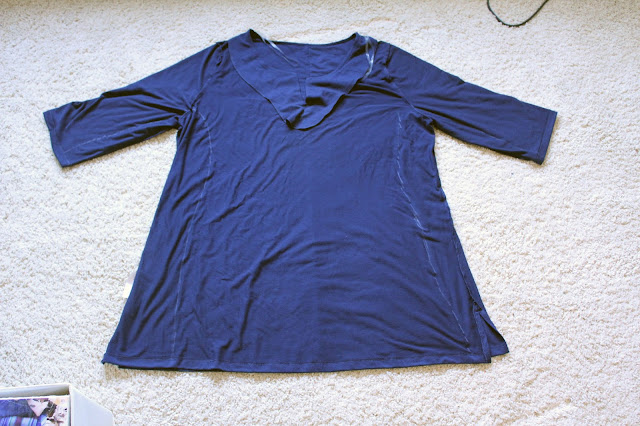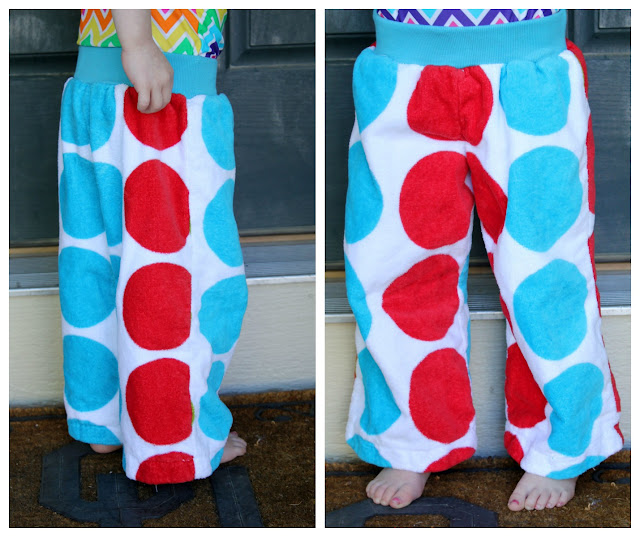Don't you love it when something actually works the way you want it to? (oops just noticed some uncut threads on my top in the photo- that didn't work the way I wanted it to :) I am happy to say this little top came out exactly how I hoped and it was so fast and easy too. I whipped up two tops the other day in about an hour and just had to share this easy and cute tutorial with you. I am not yet able to grade a pattern but I have included the one I used to make my top. It is similar to a size small in RTW, but I am sure it would be easy to make adjustments as needed. The pattern also has the color blocking variation included.

If you decide to print my pattern you will need 4 sheets of paper and some tape for piecing it together. **Make sure you do NOT overlap the pieces when taping them together, just butt them up next to one another.** You will want to make sure the pattern prints to the correct size, so you will see a 1 inch test square in the corner. This should measure one inch when printed. Match the letters on the paper (A to A, B to B, etc) until you have all your pieces taped together.
PRETTY QUICK PEPLUM PATTERN
When cutting your pattern you will use the same piece to cut your front and back pieces of the top. In order to do this, first cut out your back piece. Then either cut off the back neckline portion of the paper pattern or use a tracing wheel to transfer the front neckline mark to your fabric while cutting your front piece. I prefer to use a tracing wheel so I can reuse the pattern without having to tape it back together.
(Sorry for the grainy photo)
COLOR BLOCK VARIATION: If using the color block portion, cut your bodice top (front and back) out of one color using the line marked (Color blocking Line) on the pattern.(This is my navy blue piece below) Add 1/2 inch below that line prior to cutting out your piece for seam allowance. Then cut from the color blocking line and below in another color. (my striped pieces below) Also add the 1/2 inch above the line before cutting. You can now sew those pieces together using a 1/2 inch seam allowance. The third picture shows how to lay out your pieces before sewing. Have your solid top piece right side up and turn your striped piece upside down with the right side down. Slide the striped piece down until they line up and stitch a 1/2 inch seam. I then serged my seam and pressed the whole seam to one side. Now, follow the rest of the tutorial from step 2 on.
Now, on to the tutorial:
Step 1. Choose a nice knit with adequate stretch. You want something that is similar to the weight and stretch of a t-shirt. Cut out one front and one back piece using the pattern (or using one of your own shirts traced off for a pattern). Lay the pattern on the fold of your fabric, making sure the stretch is running across the width of your pattern.
Step 2: Lay the front and back piece on top of each other, right sides together, matching shoulder seams. Stitch across the shoulder seams using a 1/2 inch seam allowance. Serge/finish seam (optional) and press towards back.
Step 3: Stitch down both side seams using a 1/2 inch seam allowance from the armpit down. Serge/finish seam (optional) and press.
Step 4: Finish your sleeves and neckline. I tried three different techniques and you can use any of the following:
Option 1: Press your neckline/sleeve in 1/4 inch and press, then press another 1/4 inch and stitch close to the folded edge. **Your stitching will probably look much nicer than mine below. I was too lazy to change my bobbin thread and this is what happens when you sew it from the right side of the shirt instead of using your hem (on the inside) as a guide!**
Option 2: Serge the raw edge and press it under 1/4 inch, then stitch it down.
Or Option 3: (Also the most time consuming) Create bias trim from your knit fabric by cutting two strips 1 inch wide by 9 inches long (make sure the piece has stretch going the right direction b/c it will be stretched around the neckline as you sew). Sew the two short ends together to create a circle. Place the right side edge of your bias tape on the right side of your neckline and stitch a 1/4 inch seam all the way around. Make sure you stretch it slightly so that your side seams line up with your bias tape seams. Then fold the bias tape in towards your neckline's wrong side as shown in picture 3 and stitch again. (The red lines show where you should stitch). Then fold it under again towards the wrong side making sure the bias is completely hidden and stitch one last time. (The red lines show where to stitch). On the outside, the only stitching that shows is the last one you did.

Step 5: Create your bottom hem. Again, you can do a quick hem by serging the raw edge, pressing it under and stitching or a more traditional hem. For the traditional hem, press your fabric 1 inch towards the wrong side and then another 1 inch towards the wrong side and stitch near the folded edge. (sorry I do not have photos of this step).
Step 6: Insert your elastic. Cut a piece of elastic for your natural waist. I used 1/4 inch elastic and cut mine 27 inches. Mark your elastic line (on the inside or wrong side of your shirt) by using the pattern as a guide and drawing a line across both the front and the back in a disappearing or water soluble marker. This line will be your guide as you sew on the elastic.

Now, pin your elastic to one side seam, find the center of the elastic and pin it to the other side seam. This will help you see how much you need to stretch the elastic while sewing. With the elastic on top of your drawn line begin stitching. Use a regular stitch length and thread but pull the elastic while you stitch. I had to keep mine fairly tight as I stitched. I made the mistake of letting up a bit near one side seam and ended up having to redo half of it...hopefully I can save you the trouble of ripping out the elastic stitches! KEEP PULLING IT THE WHOLE TIME. Once the pieces of elastic meet, overlap them slightly and stitch it down.
And...viola, you have a quick and cute top. I hope you have enjoyed the tutorial, please feel free to email me with questions- 2ndstorysewing at gmail dot com.
Shannon





































